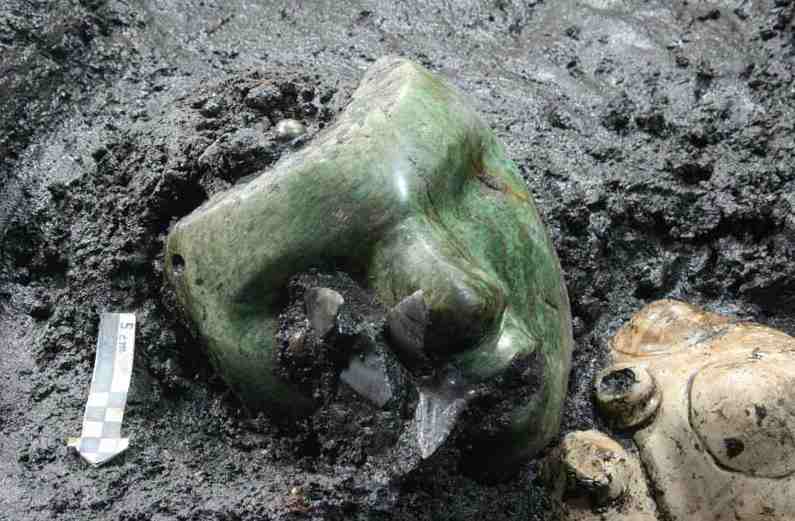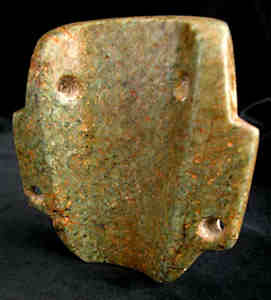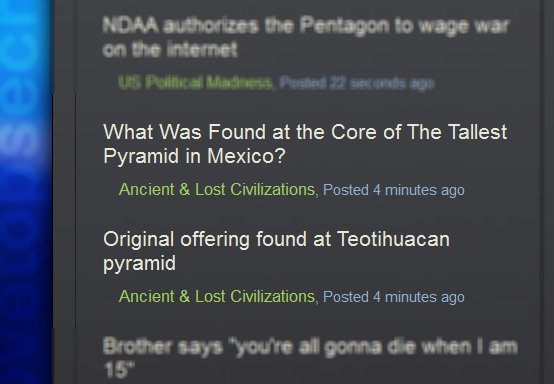It looks like you're using an Ad Blocker.
Please white-list or disable AboveTopSecret.com in your ad-blocking tool.
Thank you.
Some features of ATS will be disabled while you continue to use an ad-blocker.
share:
Well, not much according to this article. They did find a cool green mask! Anyway, not a HUGE find either way imo but that would just be so cool to
find. Does anybody know if these kinds of diggings have taken place in egypt? Perhaps I will go do a little google search and see.
Ps could anyone please paste the photo of the mask on here or tell me how, thanx. Sorry, my thread skills are still very primitive
www.theblaze.com...
Ps could anyone please paste the photo of the mask on here or tell me how, thanx. Sorry, my thread skills are still very primitive
www.theblaze.com...
The offerings found at the base of the pyramid in the Teotihuacan ruin site just north of Mexico City include a green serpentine stone mask so delicately carved and detailed that archaeologists believe it may have been a portrait.
edit on 15-12-2011 by AllUrChips because: (no reason given)
edit on 15-12-2011 by AllUrChips because: (no reason
given)
reply to post by AllUrChips
Beat your thread by 17 seconds.....
link to this thread
www.abovetopsecret.com...
Beat your thread by 17 seconds.....
link to this thread
www.abovetopsecret.com...
edit on Thu Dec 15 2011 by DontTreadOnMe because: (no reason given)
Originally posted by Hanslune
reply to post by AllUrChips
Beat your thread by 17 seconds.....
I smell a conspiracy
Excellent job
reply to post by Hanslune
Yes you did... but the article linked in this thread has pics, a video and more information than the article that you linked to in your thread.
Yes you did... but the article linked in this thread has pics, a video and more information than the article that you linked to in your thread.
edit on 15-12-2011 by puzzlesphere because: (no reason given)
Originally posted by puzzlesphere
reply to post by Hanslune
Yes you did... but the article linked in this thread has pics, a video and more information than the article that you linked to in your thread
Damn....well I guess I'll have to shave my head, become a vegetarian and join the French Foreign Legion
edit on 15/12/11 by Hanslune because:
(no reason given)

Here is a previous discovery
www.barakatgalleryuae.com...


Teotihuacan is referred to as the city of the gods. By 600 A.D. it was the sixth largest city in the world. Situated in a temperate, fertile basin its fame spread as quickly as its prosperity, with well-established trade routes and a culture that is still impressive today. With a booming economy an urban elite arose fostering intellectual activity, monumental building and the belief Teotihuacan was where the cosmos and the present cycle of life began. The concept of monumentality can apply not only to great architectural structures such as the Pyramid of the Sun, but also to much smaller objects which have an intensity that makes them larger than life. This very lovely mask falls into that category. There is a mystery surrounding this type of mask in the fact they are believed to have been part of funerary furniture, yet none have been found in burial chambers. Rather, they have been discovered near temples and complexes aligning the Street of the Dead. It is speculated they were attached to wooden armatures in temples to represent deities who are in the process of becoming gods. Hence the four drill holes. They may also have been worn on the arm as an insignia of an important person. The surface of the green stone emits palpable warmth; its face is full of compassion and serenity as if in a state of meditation. The small dot-like indentations in the eyes once contained mirror-like pyrite that would have caught the light with dazzling effect. Seeing this beautiful sculpture it is easy to imagine a secret ceremony in a temple with torches burning and masks hanging everywhere like faces from another world peering through the veil of incense.
edit on 15-12-2011 by isyeye because: (no reason given)
Originally posted by AllUrChips
Originally posted by Hanslune
reply to post by AllUrChips
Beat your thread by 17 seconds.....
I smell a conspiracy
Excellent job
I think so, I'll ask the mods to can my lesser version!
its the mask of Loki! If you put it on you become able to turn balloons into tommy guns, bounce around like a banshee, jump out of windows, make
the police force do the cha cha, and be downright hilarious
edit on 15-12-2011 by derst1988 because: (no reason given)
Originally posted by isyeye
www.barakatgalleryuae.com...
Teotihuacan is referred to as the city of the gods. By 600 A.D. it was the sixth largest city in the world.
omg the mask ! Put it on !
Teotihuacan is referred to as the city of the gods.
Teotatis the war god of the gauls who demanded human sacrifice
Kukulkan
Cú Chulainn
teo deo
2 plus two still equal three?
edit on 15-12-2011 by Danbones because: spelling
Good thing that the mask is made of stone.
A person would tend to walk into things while wearing it, no holes for the eyes.
A person would tend to walk into things while wearing it, no holes for the eyes.
The mask and the other objects appear to be made of different kinds of Jade. Jade is very hard and
difficult to work with. The Mayans were masters of jade carving.
difficult to work with. The Mayans were masters of jade carving.
Originally posted by butcherguy
Good thing that the mask is made of stone.
A person would tend to walk into things while wearing it, no holes for the eyes.
could it be a mask for the dead.
It could be.
Originally posted by citizen6511
Originally posted by butcherguy
Good thing that the mask is made of stone.
A person would tend to walk into things while wearing it, no holes for the eyes.
could it be a mask for the dead.
I wouldn't bother drilling holes for straps to hold it on their face in that case though, I would just lay it on their face. Not like they're going to be moving around much.
That mask reminds me of this mask..> The mask
Just hope it doesnt get in the wrong hands. XD
touche @ derst1988 & yourboycal2 beat me to it
Just hope it doesnt get in the wrong hands. XD
touche @ derst1988 & yourboycal2 beat me to it
edit on 15-12-2011 by strafgod because: (no reason given)
edit on 15-12-2011 by strafgod because: early bird gets the worm,
second mouse gets the cheese
that Jade stone mask has two strange drilled holes where a forehead would be
and holes through each ear of the Jade mask
i would speculate that the 'mask' was strapped on the face of the person that was to have their living heart carved out with a sacred Jade knife
the holes in the Masks ear lobes would sport the symbolic occasions need.. (it may be rain/corn/etc or whatever need of sacrifice was needed... and the appropriate symbols would dangle from the earring holes))
and holes through each ear of the Jade mask
i would speculate that the 'mask' was strapped on the face of the person that was to have their living heart carved out with a sacred Jade knife
the holes in the Masks ear lobes would sport the symbolic occasions need.. (it may be rain/corn/etc or whatever need of sacrifice was needed... and the appropriate symbols would dangle from the earring holes))
Or it could have been worn by a shaman while performing a ritual, possibly in a cave or something. Many shaman believed (especially in this culture)
that man came from underground. Often rituals would be held in caves (even if, like in England, caves have to be built inside a mound). Inside these
caves you could imbibe intoxicants, beat drums rhythmically, and begin to have experiences caused by the rhythmic drums and the sensory deprivation of
site.
Now, imagine this same type of practice performed by the priest, but the mask is what deprives the visual sensory input more than a cave. Maybe light still got in without a mask. Perhaps the mask is buried in the pyramid to return it to where it was used: inside the earth, in a cave in a mountain.
Being a ceremonial relic it would hold high religious value, I am sure.
Now, imagine this same type of practice performed by the priest, but the mask is what deprives the visual sensory input more than a cave. Maybe light still got in without a mask. Perhaps the mask is buried in the pyramid to return it to where it was used: inside the earth, in a cave in a mountain.
Being a ceremonial relic it would hold high religious value, I am sure.
This comment stood out for me.
The ‘Pyramid of the Sun’ name comes to us from the Aztecs themselves. Could this new discovery reveal the true identity of the deity the pyramid was really dedicated to? Tlaloc (Chaac), the rain god, is venerated by most Mesoamerican civilizations. It would seem appropriate that the largest of the pyramids would be dedicated to him.
In the book ‘Mesoamerican Ancient Cities’ by William M. Ferguson and Arthur H. Rohn it states this interesting observation in the Teotihuacan section.
The first quote mentions that Tlaloc has also been identified as a war god. That is the first time I have ever heard that connection to him. I have always understood him to be a rain deity and nothing more.
I looked up the Aztec war god and Huitzilopochtli came up from the wikipedia search engine.
On the other hand the pyramid of the sun might be dedicated to Huiztilopochtli because he required continuous sacrifices to keep the sun lit.
What is that object next to the mask? Is that the bottom side of some pottery? After looking up information on Huitzilopochtli I learned that his father was a ball of feathers. All the images of this god show a round object associated with him. This image caught my eye.
upload.wikimedia.org..." target='_blank' class='tabOff'/>
The circular object attached to him has 5 shells on it. I'm beginning to wonder if the circular object is meant to be a sun, moon or planet. If the color in this image has any meaning then I would call it the planet Mars, hence the war god connection in the beginning quote.
George Cowgill, an anthropologist at Arizona State University, called the find “pretty important” and suggested the Tlaloc offerings may thicken the debate about whether the pyramid was linked to the sun, the underworld or Tlaloc, who was also considered a war god
The ‘Pyramid of the Sun’ name comes to us from the Aztecs themselves. Could this new discovery reveal the true identity of the deity the pyramid was really dedicated to? Tlaloc (Chaac), the rain god, is venerated by most Mesoamerican civilizations. It would seem appropriate that the largest of the pyramids would be dedicated to him.
In the book ‘Mesoamerican Ancient Cities’ by William M. Ferguson and Arthur H. Rohn it states this interesting observation in the Teotihuacan section.
The palaces contained 40 or 50 one-story rooms arranged around a sunken central court. The walls were decorated with multicolored frescoes of gods, animals and gardens. One fresco depicts the Rain God’s paradise with dancing figures and flowering trees effused with butterflies. No other Mesoamerican city had so many painted walls.
The first quote mentions that Tlaloc has also been identified as a war god. That is the first time I have ever heard that connection to him. I have always understood him to be a rain deity and nothing more.
I looked up the Aztec war god and Huitzilopochtli came up from the wikipedia search engine.
en.wikipedia.org...
In Aztec religion, Huitzilopochtli, also spelled Uitzilopochtli (Classical Nahuatl: Huitzilopōchtli [hwitsiloˈpoːtʃtɬi] "Hummingbird on the Left", or "Left-Handed Hummingbird", huitzilin being Nahuatl for hummingbird), was a god of war, a sun god, and the patron of the city of Tenochtitlan. He was also the national god of the Mexicas of Tenochtitlan.
On the other hand the pyramid of the sun might be dedicated to Huiztilopochtli because he required continuous sacrifices to keep the sun lit.
Huitzilopochtli was said to be in a constant struggle with the darkness and required nourishment in the form of sacrifices to ensure the sun would survive the cycle of 52 years, which was the basis of many Mesoamerican myths. While popular accounts claim it was necessary to have a daily sacrifice[citation needed], sacrifices were only done on festive days. There were 18 especially holy festive days, and only one of them was dedicated to Huitzilopochtli.
What is that object next to the mask? Is that the bottom side of some pottery? After looking up information on Huitzilopochtli I learned that his father was a ball of feathers. All the images of this god show a round object associated with him. This image caught my eye.
upload.wikimedia.org..." target='_blank' class='tabOff'/>
The circular object attached to him has 5 shells on it. I'm beginning to wonder if the circular object is meant to be a sun, moon or planet. If the color in this image has any meaning then I would call it the planet Mars, hence the war god connection in the beginning quote.
edit on
17-12-2011 by lostinspace because: (no reason given)
new topics
-
ILLUMINATION: Dimensions / Degrees – Da Vincis Last Supper And The Philosophers Stone
Secret Societies: 3 hours ago -
Just Sick of It! Done! Can't take it anymore!
General Chit Chat: 4 hours ago -
Speaking of Pandemics
General Conspiracies: 6 hours ago -
Stuck Farmer And His Queue Jumping Spawn
Rant: 6 hours ago
top topics
-
Joe Biden gives the USA's Highest Civilian Honor Award to Hillary Clinton and George Soros.
US Political Madness: 17 hours ago, 15 flags -
Speaking of Pandemics
General Conspiracies: 6 hours ago, 8 flags -
Winter Storm
Fragile Earth: 17 hours ago, 7 flags -
Paradox of Progress
Ancient & Lost Civilizations: 14 hours ago, 6 flags -
ILLUMINATION: Dimensions / Degrees – Da Vincis Last Supper And The Philosophers Stone
Secret Societies: 3 hours ago, 6 flags -
Just Sick of It! Done! Can't take it anymore!
General Chit Chat: 4 hours ago, 4 flags -
Stuck Farmer And His Queue Jumping Spawn
Rant: 6 hours ago, 3 flags
active topics
-
Musk calls on King Charles III to dissolve Parliament over Oldham sex grooming gangs
Mainstream News • 128 • : Oldcarpy2 -
NJ Drones tied to Tesla explosion at Trump Las vegas
General Conspiracies • 51 • : Flyingclaydisk -
Tesla Cybertruck Explodes in Front of Trump Hotel in Las Vegas
Mainstream News • 224 • : xuenchen -
Stuck Farmer And His Queue Jumping Spawn
Rant • 4 • : Athetos -
Matthew Livelsberger said he was being followed by FBI
Political Conspiracies • 71 • : Flyingclaydisk -
Winter Storm
Fragile Earth • 24 • : Oldcarpy2 -
Joe Biden gives the USA's Highest Civilian Honor Award to Hillary Clinton and George Soros.
US Political Madness • 34 • : xuenchen -
Paradox of Progress
Ancient & Lost Civilizations • 5 • : VictorVonDoom -
Paranoid Liberals Believe U.S. Service Members are More Dangerous than Illegal Aliens.
Social Issues and Civil Unrest • 47 • : Cvastar -
Post A Funny (T&C Friendly) Pic Part IV: The LOL awakens!
General Chit Chat • 7991 • : baddmove

